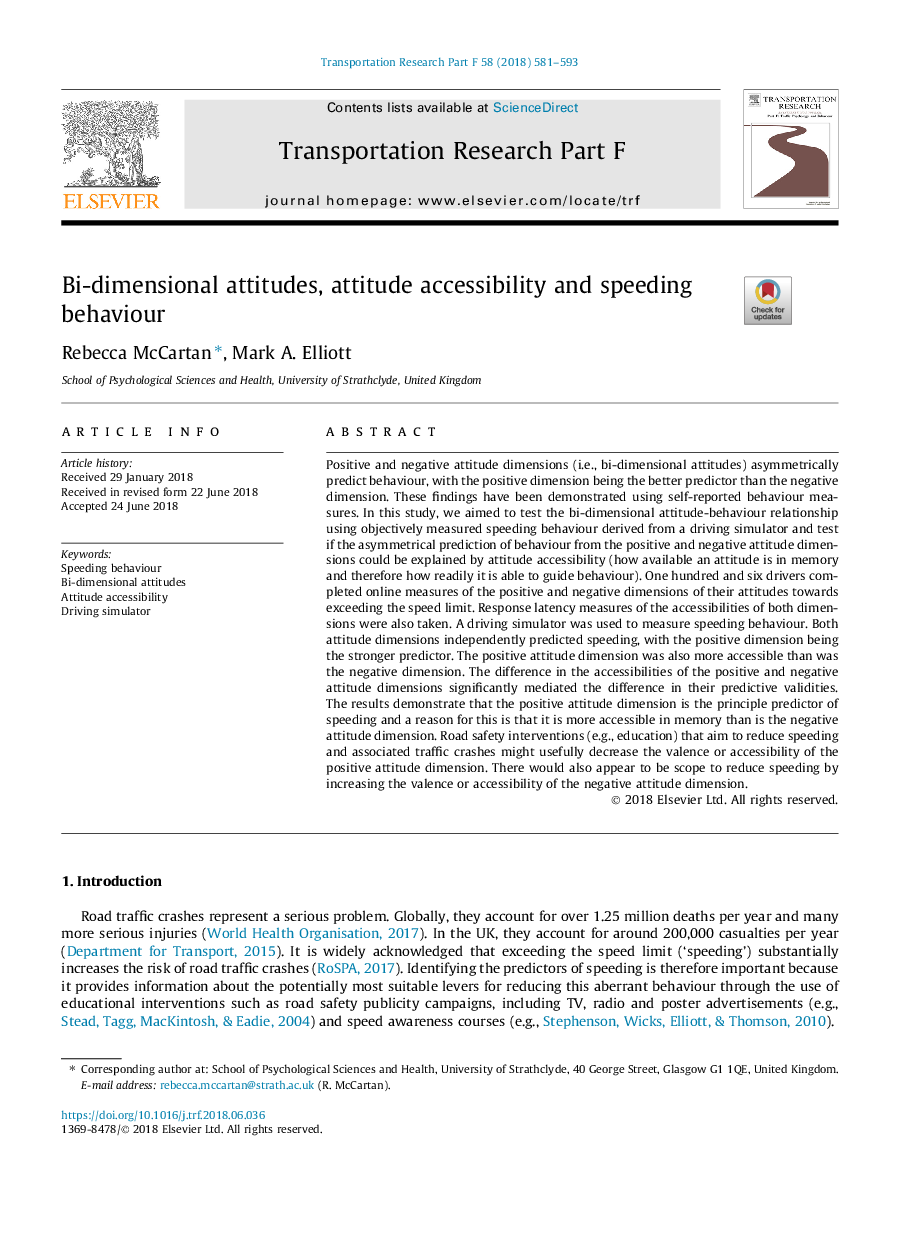| کد مقاله | کد نشریه | سال انتشار | مقاله انگلیسی | نسخه تمام متن |
|---|---|---|---|---|
| 7257652 | 1472429 | 2018 | 13 صفحه PDF | دانلود رایگان |
عنوان انگلیسی مقاله ISI
Bi-dimensional attitudes, attitude accessibility and speeding behaviour
ترجمه فارسی عنوان
نگرشهای دو بعدی، قابلیت نگرش و رفتار سریع
دانلود مقاله + سفارش ترجمه
دانلود مقاله ISI انگلیسی
رایگان برای ایرانیان
کلمات کلیدی
رفتار سریع نگرشهای دو بعدی، دسترسی به نگرش، شبیه ساز رانندگی،
ترجمه چکیده
ابعاد نگرش مثبت و منفی (یعنی نگرشهای دو بعدی) رفتار نامتقارن را پیش بینی می کنند، و بعد مثبت آن پیش بینی کننده بهتر از بعد منفی است. این یافته ها با استفاده از اقدامات رفتار خود گزارش شده است. در این مطالعه، ما با هدف بررسی رابطه نگرش رفتاری دو بعدی با استفاده از رفتار سریع سرعت سنجی عینی اندازه گیری شده از یک شبیه ساز رانندگی و آزمون، اگر پیش بینی نامتقارن رفتار از ابعاد نگرش مثبت و منفی را می توان با دسترسی نگرش (چگونه موجود است یک نگرش در حافظه است و از این رو چگونه می تواند رفتار را هدایت کند). صد و شش راننده اقدامات آنلاین ابعاد مثبت و منفی نگرش آنها نسبت به حد مجاز سرعت را تکمیل کرد. اندازه گیری های تأخیر پاسخ از قابلیت دسترسی هر دو ابعاد نیز انجام شد. یک شبیه ساز رانندگی برای اندازه گیری سرعت رانندگی استفاده می شود. هر دو ابعاد نگرش به طور مستقل پیش بینی سرعت را دارند، و بعد مثبت آن پیش بینی کننده قوی تر است. ابعاد نگرش مثبت نیز بیشتر از ابعاد منفی قابل دسترسی بود. تفاوت در قابلیت دسترسی به ابعاد نگرش مثبت و منفی، به طور قابل توجهی اختلاف در اعتبار پیش بینی شده خود را در اختیار دارند. نتایج نشان می دهد که ابعاد نگرش مثبت، پیش بینی کننده اصل سرعت است و دلیل آن این است که در حافظه قابل دسترسی تر از ابعاد نگرش منفی است. مداخلات ایمنی جاده (به عنوان مثال، آموزش) که هدف کاهش سرعت و سقوط ترافیک مربوط به آن است، ممکن است به کاهش ارزش و یا دسترسی به ابعاد نگرش مثبت کمک کند. همچنین به نظر می رسد دامنه ای برای کاهش سرعت با افزایش وضوح یا دسترسی به ابعاد نگرش منفی وجود دارد.
موضوعات مرتبط
علوم انسانی و اجتماعی
روانشناسی
روان شناسی کاربردی
چکیده انگلیسی
Positive and negative attitude dimensions (i.e., bi-dimensional attitudes) asymmetrically predict behaviour, with the positive dimension being the better predictor than the negative dimension. These findings have been demonstrated using self-reported behaviour measures. In this study, we aimed to test the bi-dimensional attitude-behaviour relationship using objectively measured speeding behaviour derived from a driving simulator and test if the asymmetrical prediction of behaviour from the positive and negative attitude dimensions could be explained by attitude accessibility (how available an attitude is in memory and therefore how readily it is able to guide behaviour). One hundred and six drivers completed online measures of the positive and negative dimensions of their attitudes towards exceeding the speed limit. Response latency measures of the accessibilities of both dimensions were also taken. A driving simulator was used to measure speeding behaviour. Both attitude dimensions independently predicted speeding, with the positive dimension being the stronger predictor. The positive attitude dimension was also more accessible than was the negative dimension. The difference in the accessibilities of the positive and negative attitude dimensions significantly mediated the difference in their predictive validities. The results demonstrate that the positive attitude dimension is the principle predictor of speeding and a reason for this is that it is more accessible in memory than is the negative attitude dimension. Road safety interventions (e.g., education) that aim to reduce speeding and associated traffic crashes might usefully decrease the valence or accessibility of the positive attitude dimension. There would also appear to be scope to reduce speeding by increasing the valence or accessibility of the negative attitude dimension.
ناشر
Database: Elsevier - ScienceDirect (ساینس دایرکت)
Journal: Transportation Research Part F: Traffic Psychology and Behaviour - Volume 58, October 2018, Pages 581-593
Journal: Transportation Research Part F: Traffic Psychology and Behaviour - Volume 58, October 2018, Pages 581-593
نویسندگان
Rebecca McCartan, Mark A. Elliott,
